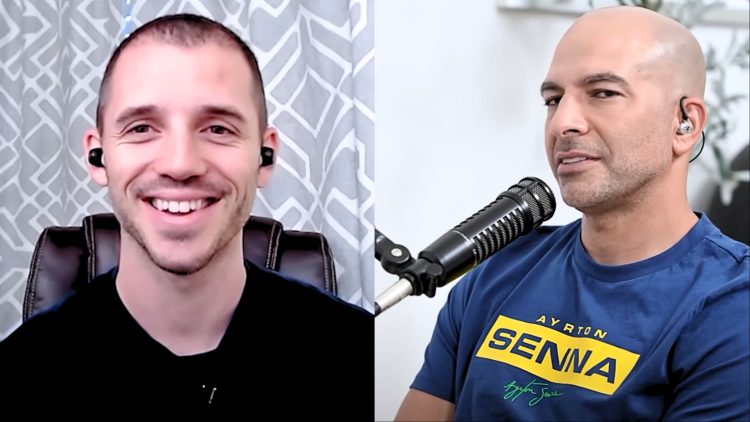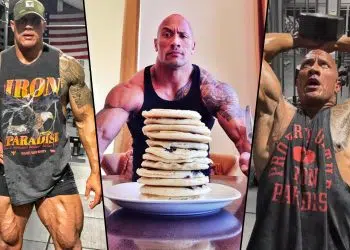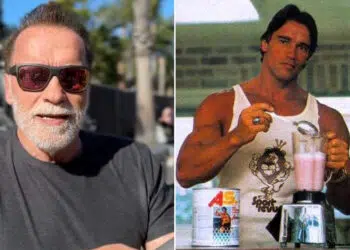Esteemed fitness experts Dr. Andy Galpin and Dr. Peter Attia joined forces for a crash course into understanding hypertrophy on a cellular level. In a recent YouTube video, Galpin and Attia examined the biology behind muscle-building and broke down the differences between contractile and sarcoplasmic hypertrophy.
Building quality muscle is on most people’s to-do lists nowadays, and they are always seeking new and exciting ways to further their fitness goals. The same can be said for Dr. Andy Galpin, a tenured professor of Kinesiology at California State University.
He also served as a scientist at CSU Fullerton, where he built an astounding reputation examining muscle development, athletic performance, recovery, and supplementation. Galpin has put his knowledge to the test as well, having helped train UFC athletes like former title challenger Brian Ortega.
Dr. Peter Attia is another highly respected voice in the fitness sector. In addition to sharing his longevity-inspired sleep, supplement, and training routine, he gives back to the community with insightful dialogues with other exercise masterminds. He recently examined if the benefits of squats and deadlifts outweigh the risk of injury. And now, he joined Dr. Galpin for a candid and in-depth discussion about hypertrophy.
Level Up Your Fitness: Join our 💪 strong community in Fitness Volt Newsletter. Get daily inspiration, expert-backed workouts, nutrition tips, the latest in strength sports, and the support you need to reach your goals. Subscribe for free!
Dr. Andy Galpin and Dr. Peter Attia Examine Hypertrophy on a Cellular Level
Dr. Andy Galpin describes his interpretation of hypertrophy on a cellular level, comparing the muscle to a cylinder that expands depending on growth.
“There’s an interesting discussion here, the easy answer is when we generally say hypertrophy what we are referring to is diameter or a cross-sectional area. So, if you remember if you think about the muscle fibers being that cylinder, the width of the cylinder just expands. That circle gets larger, that’s a way to think about it,” explains Dr. Andy Galpin.
Next, Galpin discusses sarcoplasmic and contractile hypertrophy. He pointed to the uncertainty of fluid in the muscles affecting how scientists examine hypertrophy.
“From a skeletal muscle perspective, the diameter gets larger. There’s actually interesting work, we actually have some tissue on its way to Auburn right now because one of the things that’s been interesting it’s a like a bro science thing for years of sarcoplasmic hypertrophy versus contractile hypertrophy.
So what this is really positing is, is the change really coming from fluid retention basically, or is it actually enhanced of the contractile tissue which in this case would be an active? It seems there’s some work there that’s a bit of both and it happens in different phases.”
Galpin defined sarcoplasmic hypertrophy as an increase in muscle diameter with additional fluid.
“Yeah… so it’s closed not the sarcoplasmic reticulum, this is what we call the sarcoplasm hypertrophy. This would just be an increase in diameter with additional fluid. It’s close to what you’re saying. In other words, does this thing even exist in other words is all increases in muscle size through strength training assuming it’s like a normal positive adaptation.”
“Even a few years ago, the idea that sarcoplasmic hypertrophy was a thing was thought of as garbage bro science,” said Galpin.
To illustrate the dynamic nature of hypertrophy, Dr. Galpin looked at why a bodybuilder might have more muscle but isn’t stronger than a strongman.
“What the question is, here’s where the exercise scientist comes in, why is it a bodybuilder can have more muscle yet they are not stronger than a strongman or a weightlifter? How does that actually happen? This is where this whole thing comes about.
How is it that my hypertrophy can exceed yours but somehow you’re stronger? The easy sophomore answer is neurological adaptations. Okay, fine. Sure, but there’s nothing happening intracellularly? I don’t think that’s correct and that doesn’t look to be the case.”
While contractile hypertrophy translates to more strength, Galpin underlined how sarcoplasmic hypertrophy can result in bigger muscles.
“If that hypertrophy was coming simply from excessive fluid and not actually contractile, then you would actually have a larger muscle, and when I say fluid retention, I’m not talking about acute fluid retention. I’m not saying like you’re bloated today, you’ve water-loaded.
I mean just there’s some enhanced fluid and a homeostatic balance inside the tissue because diameter has gotten larger but it wasn’t met with an equal amount of increase in contracti units. So that number gets off.”
Evidence-backed fitness tips are in high demand right now, and fortunately, there is a wealth of resources available for those aiming to level up. Cell biologist Dr. Rhonda Patrick continues to give back to the community. She recently broke down her ‘Norwegian 4×4 protocol’ for making your heart 20 years younger.
With minds like Dr. Andy Galpin and Dr. Peter Attia focusing on hypertrophy through a scientific lens, enthusiasts today have an unprecedented wealth of knowledge at their fingertips, empowering them to make informed choices on their fitness journeys.
RELATED: Rest Time for Hypertrophy: How Long Between Sets for Maximal Muscle Growth?









